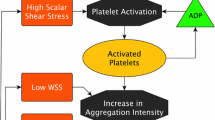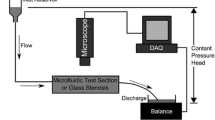Abstract
A numerical model of thrombosis/thromboembolism (T/TE) is presented that predicts the progression of thrombus growth and thromboembolization in low-shear devices (hemodialyzers, oxygenators, etc.). Coupled convection–diffusion-reaction equations were solved to predict velocities, platelet agonist (ADP, thromboxane A2, and thrombin) concentrations, agonist-induced and shear-induced platelet activation, and platelet transport and adhesion to biomaterial surfaces and adherent platelets (hence, thrombus growth). Single-platelet and thrombus embolization were predicted from shear forces and surface adhesion strengths. Values for the platelet-biomaterial reaction constant and the platelet adhesion strength were measured in specific experiments, but all other parameter values were obtained from published sources. The model generated solutions for sequential time steps, while adjusting velocity patterns to accommodate growing surface thrombi.
Heparinized human blood was perfused (0.75 ml/min) through 580 μm-ID polyethylene flow cells with flow contractions (280 μm-ID). Thrombus initiation, growth, and embolization were observed with videomicroscopy, while embolization was confirmed by light scattering, and platelet adhesion was determined by scanning electron microscopy.
Numerical predictions and experimental observations were similar in indicating: 1) the same three thrombotic locations in the flow cell and the relative order of thrombus development in those locations, 2) equal thrombus growth rates on polyethylene and silicon rubber (in spite of differing overall T/TE), and 3) similar effects of flow rate (1.5 ml/min versus 0.75 ml/min) on platelet adhesion and thrombosis patterns.
Similar content being viewed by others
References
Aarts, P. A. M., P. Steeniuk, J. J. Sixma, and R. M. Heethaar. Fluid shear as a possible mechanism for platelet diffusivity in flowing blood. J. Biomech. 19(10):799–805, 1986.
Adams, G. A., and I. A. Feuerstein. Platelet adhesion and release: Interfacial concentration of released materials. Am. J. Physiol. 240:H99–H108, 1981.
Adams, G. A., and I. A. Feuerstein. Maximum fluid concentrations of materials released from platelets at a surface. Am. J. Physiol. 244:H109–H114, 1983.
Baldwin J. T., S. Deutsch, D. B. Geselowitz, and J. M. Tarbell. Estimation of Reynolds stresses within the Penn State left ventricular assist device. ASAIO Trans. 36:M274–M278, 1990.
Basmadjian, D. Embolization: Critical thrombus height, shear rates, and pulsatility. Patency of blood vessels. J. Biomed. Mater. Res. 23(11):1315–1326, 1989.
Basmadjian, D. The effect of flow and mass transport in thrombogenesis. Ann. Biomed. Eng. 18(6):685–709, 1990.
Born, G. V. R. Research on the mechanism of the intravascular adhesion of circulating cells. In: Platelets and Thrombosis, edited by S. Sherry and A. Scriabin. Baltimore: University of Park Press, 1972, pp. 113–126.
DeSomer F., L. Foubert, M. Vanackere, D. Dujardin, J. Delanghe, and G. Van Nooten. Impact of oxygenator design on hemolysis, shear stress, and white blood cell and platelet counts. J. Cardiothorac. Vasc. Anesth. 10(7):884–889, 1996.
Eloot S., D. De Wachter, I. Van Tricht, and P. Verdonck. Computational flow modeling in hollow-fiber dialyzers. Artif. Org. 26(7):590–599, 2002.
Feuerstein, I. A., J. M. Brophy, and J. L. Brash. Platelet transport and adhesion to reconstituted collagen and artificial surfaces. Trans. Amer. Soc. Artif. Int. Organs 21:427–435, 1975.
Feuerstein, I. A., and S. M. Buchan. Platelet adherence and detachment: A flow study with a series of hydroxyethyl methacrylate-ethyl methacrylate copolymers using video microscopy. J. Biomed. Mater. Res. 25:185–198, 1991.
Fogelson, A. L. Continuum models of platelet aggregation: Formulation and mechanical properties. J. Appl. Math. 52:1089–1110, 1992.
Folie, B. J., and L. V. McIntire. Mathematical analysis of mural thrombogenesis. Concentration profiles of platelet-activating agents and effects of viscous shear flow. Biophys. J. 56(6):1121–1141, 1989.
Frojmovic, M. M., R. F. Mooney, and T. Wong. Dynamics of platelet glycoprotein IIb-IIIa receptor expression and fibrinogen binding. I. Quantal activation of platelet subpopulations varies with adenosine diphosphate concentration. Biophys. J. 67:2060–2068, 1994.
Frojmovic, M. M., T. Wong, and T. van de Ven. Dynamic measurements of the platelet membrane glycoprotein IIb-IIIa receptor for fibrinogen by flow cytometry. I. Methodology, theory and results for two distinct activators. Biophys. J. 59:815–827, 1991.
Fung, Y. C. Biodynamics: Circulation. New York: Springer-Verlag, 1984.
Giacomini, A., P., Legovini, F. Antico, G. S. Gessoni, S. Valverde, M. M. Salvadego, and F. Manoni. Evaluation of platelet analysis on the ADVIA 120 Hematology System. Lab. Hematol. 7:180–185, 2001.
Goldsmith, H. L., and V. T. Turitto. Rheological aspects of thrombosis and haemostasis: Basic principles and applications. Thromb. Haemost. 55(3):415–435, 1986.
Goodman, P. D., M. W. Hall, S. Sukavaneshvar, and K. A. Solen. In vitro model for studying the effects of hemodynamics on device induced thromboembolism in human blood. ASAIO J. 46:576–578, 2000.
Grabowski, E. F., J. T. Franta, and P. Didisheim. Platelet aggregation in flowing blood in vitro. II. Dependence of aggregate growth rate on ADP concentration and shear rate. Microvasc. Res. 16:183–195, 1978.
Grabowski, E. F., L. I. Friedman, and E. F. Leonard. Effects of shear rate on the diffusion and adhesion of blood platelets to a foreign surface. Ind. Eng. Chem. Fundam. 11(2):224–232, 1972.
Griffith, M. J. Kinetics of the heparin-enhanced antithrombin III/thrombin reaction. Evidence for a template model for the mechanism of action of heparin. J. Biol. Chem. 257:7360–7365, 1982.
Griffith, M. J. The heparin-enhanced antithrombin III/thrombin reaction is saturable with respect to both thrombin and antithrombin III. J. Biol. Chem. 257:13899–13902, 1982.
Gu Y. J., P. W. Boonstra, R. Graaff, A. A. Rijnsburger, H. Mungroop, and W. van Oeveren. Pressure drop, shear stress, and activation of leukocytes during cardiopulmonary bypass: A comparison between hollow fiber and flat sheet membrane oxygenators. Artif. Org. 24(1):43–48, 2000.
Hellums, J. D. 1993 Whitaker Lecture: Biorheology in thrombosis research. Ann Biomed. Eng. 22(5):445–455, 1994.
Hubbell, J. A., and L. V. McIntire. Platelet active concentration profiles near growing thrombi. Biophys. Soc. 50:937–945, 1986.
Jen, C. J., H. Li, J. Wang, H. Chen, and S. Usami. Flow-induced detachment of adherent platelets from fibrinogen-coated surface. Heart Circ. Physiol. 39:H160–H166, 1996.
Jones, R. L., N. H. Wilson, and C. G. Marr. In: Chemistry, Biochemistry, and Pharmacological Activity of Prostanoids, edited by S. M. Roberts and F. Scheinmann. Oxford: Pergamon Press, 1979, pp. 210–220.
Karnovsky, M. J. A formaldehyde-glutaraldehyde fixative of high osmolarity for use in electron microscopy. J. Cell Biol. 27:137, 1965.
Kennedy, S. D., Y. Igarashi, and T. S. Kickler. Measurement of in-vitro P-selectin expression by flow cytometry. Am. J. Clin. Pathol. 107:99–104, 1997.
Langford, E. F., R. J. Wainwright, and J. F. Martin. Platelet activation in acute myocardial infarction and unstable angina is inhibited by nitric oxide donors. Arterioscler. Thromb. 16:51–55, 1996.
Lemire P. P., J. C. McDaniel, H. G. Wood, P. E. Allaire, N. Landrot, X. Song, S. W. Day, and D. Olsen. The application of quantitative oil streaking to the HeartQuest left ventricular assist device. Artif. Org. 26(11):971–973, 2002.
Mandrusov, E., J. D. Yang, N. Pfeiffer, L. Vroman, E. Puszkin, and E. F. Leonard. Kinetics of protein deposition and replacement from a shear flow. AICHE J. 44(2):233–244, 1998.
McPherson, L. B., J. D. Hellums, C. P. Alfrey, and E. C. Lynch. Platelet retention in glass bead columns: Further evidence for the importance of ADP. Blood 44:411–425, 1972.
Merrill, E. W., and G. A. Pelletier. Viscosity of human blood: Transition from Newtonian to non-Newtonian. J. Appl. Physiol. 23(2):178–182, 1967.
Reynolds, L. O., W. H. Newren, J. F. Scolio, and I. F. Miller. A model for thromboembolization on biomaterials. J. Biomater. Sci. Polymer Ed. 4(5):451–465, 1993.
Ronco C., A. Brendolan, C. Crepaldi, M. Rodighiero, and M. Scabardi. Blood and dialysate flow distributions in hollow-fiber hemodialyzers analyzed by computerized helical scanning technique. J. Am. Soc. Nephrol. 13(Suppl. 1):S53–S61, 2002.
Rosing, J., J. L. M. L. van Rijn, E. M. Bevers, G. Van Dieijen, P. Comfurius, and R. F. A. Zwaal. The role of activated human platelets in prothrombin and factor X activation. Blood 65:319–332, 1985.
Solen K. A., S. Sukavaneshvar, Y. Zheng, B. Hanrahan, M. W. Hall, P. Goodman, B. Goodman, and S. F. Mohammad. A light scattering instrument to detect thromboemboli in blood. J. Biomed. Opt. 8:70–79,2003.
Sorensen, E. N., G. W. Burgreen, W. R. Wagner, and J. F. Antaki. Computational simulation of platelet deposition and activation: I. Model development and properties. Ann. Biomed. Eng. 27(4):436–448, 1999.
Sorensen, E. N., G. W. Burgreen, W. R. Wagner, and J. F. Antaki. Computational simulation of platelet deposition and activation: II. Results for Poiseuille flow over collagen. Ann. Biomed. Eng. 27(4):449–458, 1999.
Strong, A. B. Theoretical and experimental analysis of cellular adhesion to polymer surfaces. J. Biomed. Mater. Res. 21:1039–1055, 1987.
Stubley, G. D., A. B. Strong, W. E. Hale, and D. R. Absolom. A review of mathematical models for the prediction of blood cell adhesion. Phys. Chem. Hydrodyn. 8(2):221–235, 1987.
Treichler J., S. E. Rosenow, G. Damm, K. Haito, Y. Ohara, K. Mizuguchi, K. Makinouchi, S. Takatani, and Y. Nosé. A fluid dynamic analysis of a rotary blood pump for design improvement. Artif. Org. 17(9):797–808,1993.
Tschopp, T. B. and H. R. Baumgartner. Enzymatic removal of ADP from plasma: Unaltered platelet adhesion but reduced aggregation on subendothelium and collagen fibrils. Thromb. Haemost. 35:334–341, 1976.
Turrito, V. T., and H. R. Baumgartner. Platelet deposition on the subendothelium exposed to flowing blood: Mathematical analysis of physical parameters. Trans. Amer. Soc. Artif. Int. Organs 21:593–601, 1975.
Weiss, H. J., and W. A. Smith. Platelets: Pathophysiology and Antiplatelet Drug Therapy. New York: Liss, 1982.
Wooton, D. M., C. P. Markou, S. R. Hanson, and D. N. Ku. A mechanistic model of acute platelet accumulation in thrombogenic stenoses. Ann. Biomed. Eng. 29(4):321–329, 2001.
Wu, Y. P., P. G. de Groot, and J. J. Sixma. Shear-stress-induced detachment of blood platelets from various surfaces. Arterioscler. Thromb. Vasc. Biol. 17(11):3202–3207, 1997.
Author information
Authors and Affiliations
Corresponding author
Rights and permissions
About this article
Cite this article
Goodman, P.D., Barlow, E.T., Crapo, P.M. et al. Computational Model of Device-Induced Thrombosis and Thromboembolism. Ann Biomed Eng 33, 780–797 (2005). https://doi.org/10.1007/s10439-005-2951-z
Received:
Accepted:
Issue Date:
DOI: https://doi.org/10.1007/s10439-005-2951-z




